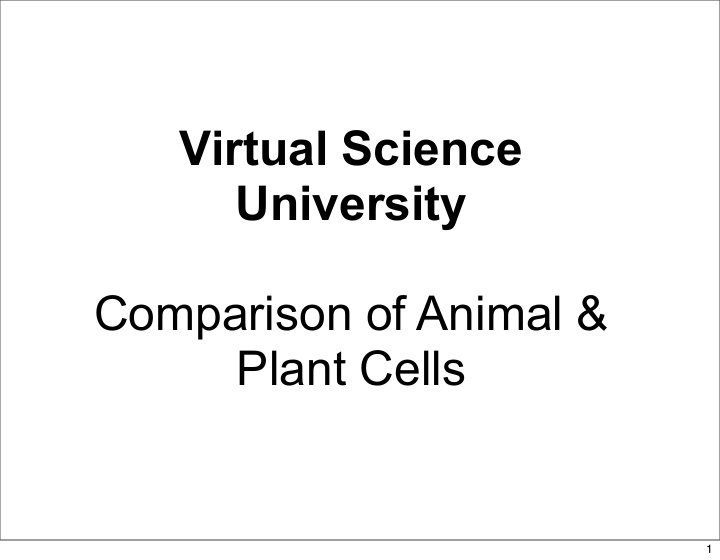



Virtual Science University Comparison of Animal & Plant Cells 1
Comparison of Animal & Plant Cell • Texas TEK Objective • B.5 (A) Student will compare cells from different parts of plants and animals including roots, stems, leaves, epithelia, muscles, and bones to show specialization of structure and function. • Note: All Plant slides courtesy of Iowa State University Lab Topic 24 2
Comparison of Animal & Plant Cells Emphasis on Plant cells and Plant Tissues As you recall from my previous lecture on Cell Structure and Function, there were eight organelles that were discussed. Remember an organelle is a tiny little organ with a specific function. The organelles mentioned are: Endoplasmic Reticulum, Nucleus, Mitochondria, Cell Membrane, Cell Wall, Chloroplast, Golgi Apparatus, and Lysosome. If you recall, the Cell Wall and Chloroplasts are found only in Plant Cells. Here is a general picture of an animal and plant cell… Animal Cell Plant Cell 3
Epithelia & Stems Tissue • Epithelia tissues are avascular tissues which are without blood. They cover and line body surfaces like hollow organs and body cavities. They also form organs and are the tissues from which gametes sperm and egg cells develop. Epithelia tissues are largely closely knit packed cells. They have very little or no intercellular material and the cells are arranged in single continuous sheets called simple tissue or multilayered sheets called stratified tissue. Epithelia undergo mitosis or cell division which is the way that tissue is renewed. • Stems in plants have vascular tissues. Their vascular tissue like xylem and phloem carry water and nutrients from the roots all the way up to specialized tissues like leaves and flowers. Xylem have hard walled cells which transport water and mineral nutrients. Phloem tissue are made up of soft walled cells which transport organic nutrients. 4
Epithelia • Simple Epithelium Tissue Stratified Epithelium Tissue 5
Root & Stem Tissues • Root Meristematic Tissue Stem Meristamatic Tissue 6
Leaf Structure • Leaves primarily undergo photosynthesis. They are the primary photosynthetic structures of the plant. Most leaves have a flattened portion called the blade. The blade is often attached to a stalk called the petiole. A leaf is vascular and has ground tissue covered by an epidermis as seen in the following diagram. A cuticle, which is a waxy covering covers the upper and lower epidermis, keeps the plant from losing excess water. The leaf also is closely packed with columnar cells which contain huge volumes of chloroplasts. Both xylem and phloem are found in the veins of a leaf. Veins are vascular tissue which extend from the tips of the roots to the edges of leaves. Ground tissue is called the mesophyll in the leaf. Again the mesophyll is closely packed with chloroplasts which is where photosynthesis occurs. The palisade layer which is under the epidermis has one or more columns of closely packed columnar cells which contain chloroplasts. Stomata are tiny holes in the epidermis which connect air spaces to the outside air. 7
Leaf Tissue • Structure of a Leaf 8
Skeletal Muscle Structure • Skeletal muscle is made up of skeletal muscle fibers associated with smaller amounts of blood vessels, connective tissue, and nerves. Skeletal muscle fiber is the same as skeletal muscle cell. Every individual muscle fiber is a cylindrical cell containing several nuclei located around the vicinity of the fiber near the cell membrane. The muscle fibers develop from multinucleated cells called myoblasts. The myoblasts are converted to muscle fibers as proteins which are contractile accumulate within their cytoplasm. 9
Striated Skeletal Muscle • Located eccentrically, multiple nuclei accompany individual cells, each of which contain many myofibrils. 10
Cardiac Muscle • Cardiac Muscle tissue containing nuclei, striations, and intercalated discs. 11
Bone • Cross section of bone tissue. 12
Cartilage • Cartilage in the knee found as Lateral and Medical Meniscus. Meniscus is another term for cartilage that is found on top of the tibial table of the knee. 13
Contact Information www.VirtualScienceUniversity.com 1-877-920-5550 14
Recommend
More recommend